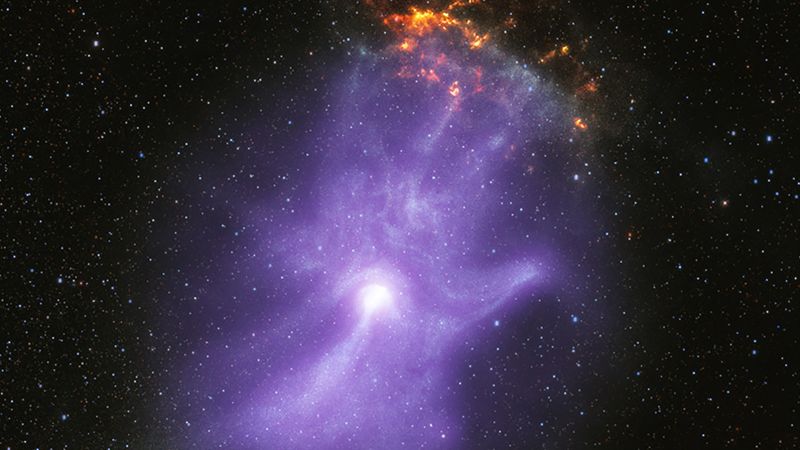
NASA/CXC/Stanford University/R. Roman et al.
Data from NASA’s Chandra X-ray Observatory and the X-ray Polarimetry Explorer contributed to this composite image of a nebula resembling a glowing hand.
Sign up for CNN’s Wonder Theory science newsletter. Explore the universe with news of fascinating discoveries, scientific advances and more.
CNN
—
The universe is full of mysteries waiting to be solved, and some of them seem especially strange come Halloween.
Jupiter’s haunting “face,” a ghostly nebula, and a hand-shaped skeleton are just two of the eerie celestial features recently observed by NASA missions.
The Juno mission, which has been orbiting Jupiter and some of its largest moons since 2016, made its 54th close flyby of the largest planet in our solar system on September 7. The JunoCam instrument captured clouds and swirling storms in Jupiter’s northern regions along the planet’s terminus, or the line that separates the day side from the night side.
NASA/JPL-Caltech/SwRI/MSSS/Vladimir Tarasov
Jupiter’s swirling atmosphere appears to include a face in this image captured by JunoCam.
A Picasso-like face appears to emerge from the turbulent atmosphere in a phenomenon called pareidolia, in which viewers spy faces and other recognizable objects within random patterns.
Primary data is publicly available on JunoCam websiteIt was processed by citizen scientist Vladimir Tarasov. During the close pass, Juno flew about 4,800 miles (7,700 kilometers) above the planet’s cloud tops, where the low angle of sunlight added to the dramatic nature of the image.
X-rays were first used by physicist Wilhelm Röntgen to image the bones of his wife’s hand in 1895 – and now, two X-ray telescopes have revealed the ‘bones’ of a glowing hand-shaped cloud that formed in the wake of a star meteorite. Collapses.
The cloud of gas and dust, or nebula, formed 1,500 years ago when a massive star burned through its internal nuclear fuel and collapsed. The nebula, known as MSH 15-52, is located about 16,000 light-years from Earth.
NASA/MSFC
Chandra’s original image of the nebula shows the pulsar, the bright white spot inside the “palm,” while the orange cloud is the remnants of a supernova explosion.
When the star collapsed, it left behind a dense remnant known as a neutron star. Fast-spinning neutron stars that have strong magnetic fields are called pulsars. Newly formed pulsars send out jets of energetic material and have strong winds, which led to the formation of this particular nebula.
The pulsar, known as PSR B1509-58, was first observed by NASA’s Chandra The outflow from the pulsar can be traced back to the ‘wrist’.
More than 20 years later, NASA’s X-ray Polarimetry Explorer, or IXPE, spent 17 days observing the nebula. This is the space observatory’s longest observing campaign since then It will be launched in December 2021. The results of the new telescope’s operations were published on Monday Astrophysical Journal.
“The IXPE data give us the first map of the magnetic field in the hand,” lead study author Roger Romani, a professor of physics at Stanford University in California, said in a statement. “The charged particles that produce the X-rays travel along the magnetic field, determining the basic shape of the nebula, much as bones do in a human hand.
The telescope’s unique observing capabilities allow scientists to pinpoint where particles in the nebula are being accelerated by turbulent regions within the magnetic field.

“Web maven. Infuriatingly humble beer geek. Bacon fanatic. Typical creator. Music expert.”





More Stories
72-million-year-old fossil found near Utah leads to discovery of muskrat-sized prehistoric mammal
A massive swarm of black holes has been discovered moving through the Milky Way, scientists report
Boeing’s losses on the Starliner increased by $250 million